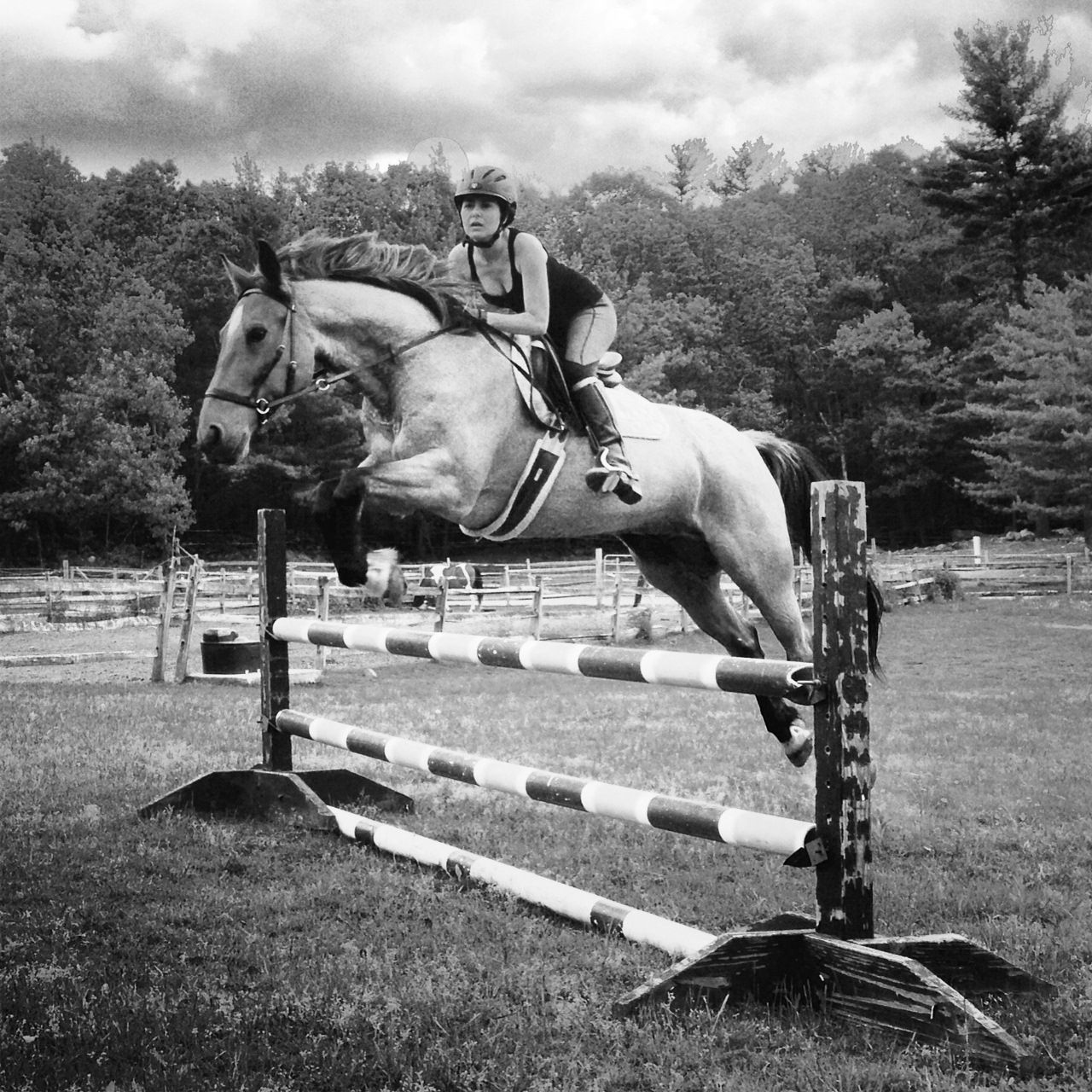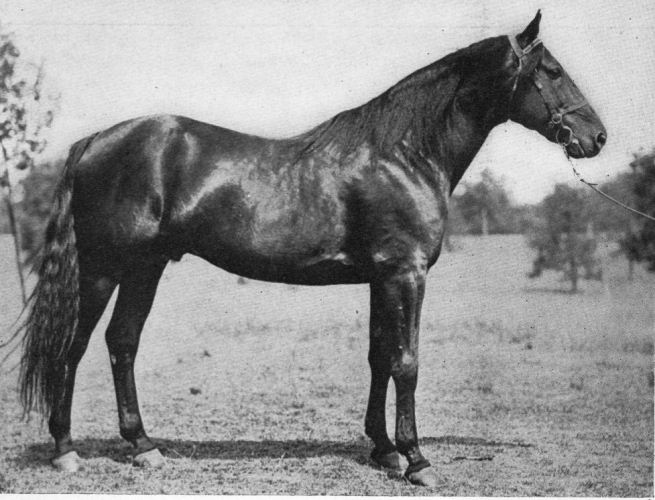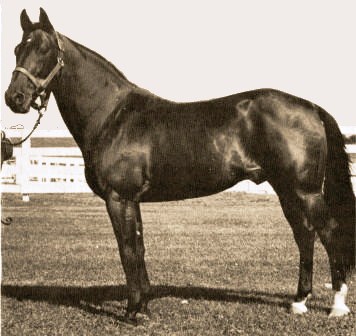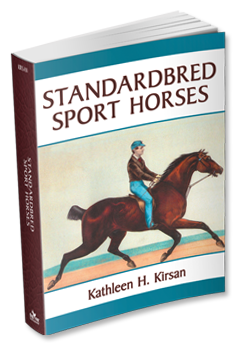Standardbred Sport Bloodlines
As you plainly see in the WEG performers and in the Standardbred article the Standardbred can be taken right off the track, just like the Thoroughbred (OTTB), and it too retrained for use in all manner of sport with great success. Also, this is a breed for the sport breeders to consider, it is an extremely potent breed that can be crossed into your sport herd to improve the performance, soundness and add speed and stamina. It is a breed with versatile talents, sound and sane and with a tremendous work ethic. The Standardbred is possibly the greatest genetic sport resource we can access in our breeding programs. This article is a brief look at some of the Standardbred sport bloodlines that are a proven purveyors of Olympic style sport talent.
[Below is Brianna Touzjian and her full Standardbred Merlin, a natural jumper who is so calm and easy she can ride and jump him in a halter. He is jumping on the same power lines as Regina Z: heavy in Volomite ST and Guy Axworthy ST.]

The Standardbred carries the best genes for Olympic style sport. Huh? While researching and writing Standardbred Sport Horses I found this breed is absolutely loaded with not only the best Thoroughbred and distance Running Horse bloodlines, but it also has the best of our saddle strains, our jumping traits and even dressage ability in vast amounts. I was truly amazed at what I found. And on top of all that it has the best temperament, and the best feet and legs of all the sport breeds. It is especially valuable for us in the States because it contains bloodlines that are natural genetic bridges to the talented lines in our other sport breeds, giving us the opportunity of building up background power of excellence in our lineages.
But there is more. Recently I conducted a extensive study on sound bloodlines and their source in the Standardbred. Inspired by the astounding career of Foiled Again, who before retiring at the end of 2018 amassed 109 wins!
I am truly excited about the future for the American breeder of sport horses--we have it all here, and we did not even recognize it! I think because we have had such a long Hunter Horse tradition, right from the earliest colonial times, that we did not really value our stock as something precious, assuming that all breeds and all countries had the same resources. But they don't and didn't. Yes, we got our base stock from Ireland and England--and our breeds are closely related to theirs We have a genetic advantage because we did not eradicate the original strains, instead we kept all the traits of that wonderful colonial breed intact, while in the British Isles the majority of those pre-Thoroughbred racers were destroyed in their civil wars.
As I have said elsewhere, the fact that we nurtured all the strains of our Running Horse instead of destroying them is why we have three racehorse breeds here in the States, not one. But it is way better than that, we have four other pure-bred sport breeds directly descended from that same stock as well: Morgan, Saddlebred, Tennessee Walker and Missouri Fox Trotter, and all seven of our breeds are perfect for crossing with each other because of the common background strains. When you cross our breeds you are reinforcing sport genetics, not farm horse, not coach horse, but unadulterated sport...no other country has this depth and richness in true sport genetics in their gene pool.
While I was evaluating all the sport horses that carry Standardbred or are pure-Standardbred I discovered a few things. One is that the bloodlines that succeed in Olympic style sport are the same ones that excel at racing. You might think that those purposes are counterproductive--racing versus jumping or dressage, but they are not. Some are better for jumping of course and others have surfaced as dressage lines. Some of the bloodlines are present in all forms of sport. I will go over a few of the main roots here briefly, but I do suggest that in you find you want more information on these and other relevant bloodlines you get Standardbred Sport Horses as a reference.

[An extraordinarily balanced athlete, George Wilkes AT 1856 was able to race equally at the trot and the pace, truly dual-gaited, and his gaits were pure, not mixed. He passed on his high athleticism, balance and gait purity and his wonderful temperament. His bloodline is found more often than any other son of Hambletonian AT in horses that excel at Olympic style sport.--drawing by George Morris]
Of all the Hambletonian sons I found that George Wilkes AT far exceeds the others in successful sport horse lineages, Electioneer AT comes fairly close, but truly it is George Wilkes AT that fills up the background more than any other.
The later line of Peter the Great ST is always there in multiples and more recently Volomite ST 1926 is found continuously no matter the sport expression. Volomite ST, a trotter himself, threw an equal number of trotters and pacers.

[The mighty Volomite ST, a power behind all types of sport: trotting, pacing, jumping, eventing and dressage, no matter the discipline his line is present in multiples--public domain image]
A line found in multiples in the natural jumpers is Guy Axworthy ST. He is very potent--inbred 3x2 to full brothers: William L AT and Guy Wilkes AT, by George Wilkes AT out of Lady Bunker AT. The beautiful square balanced form is clearly dominant in this line. Often combined with multiples of Volomite ST in top jumpers--such as in Merlin pictured at article start.

[Guy Axworthy ST 1902, a fantastic sire of winners in racing and now jumping--public domain image]
Now here is a surprise: the powerful ability to perform the highly collected trot-based advanced dressage movements of the passage and the piaffe appear to be transferred with dominance in Adios ST, especially when present with his full sister Adieu ST and 7/8 sister Overbid--but they are all free-legged pacers. How can a pacer be a sure transmitter of this ability? I don't know the answer to that, and the science on the gait-keeper gene says it is impossible...Nevertheless, the reality is this line passes on this talent consistently.

[Adios ST, a free-legged pacer, and one of the greatest sires of winners in the modern racing Standardbred--he is also found continuously in power in the Standies that excel in dressage--ATA photo.]
Adios ST and his sire Hal Dale ST are found in dominance in top dressage horses such as Whiz Bang ST and Sea the Gray ST who performed beautifully at the World Equestrian Games. Other lines often found in conjunction with Adios ST in the dressage stars are of course Volomite ST and Billy Direct ST. It is interesting that the Hal Dale ST-Adios ST line is inbred to Gibsons Tom Hal RH, and this line is prevalent also in the Tennessee Walkers a breed that also excels in dressage--both gaited and regular dressage.
The above are just some brief examples of vibrant sport conduits in the Standardbred, realize there are others. In the modern top sire lines like Meadow Skipper, Speedy Crown ST, Stars Pride ST, Albatross ST and many others, you will find all have powerfully designed pedigree structures, with tight line-breeding and/or inbreeding--see the top modern sire Muscle Hill ST for an example. For the breeder of sport horses this is a bonus, because if you choose to cross with a Standie, you can easily find a bloodline that carries dominance in the traits you are hoping to bring in, plus because of the strong pedigree structure it guarantees you will get the genetics in force. Standardbreds are perfect for crossing with your sport horses that are tightly bred themselves--when brought together you will not just get the transfer of the talents of both parents, but a hybrid vigor factor as well. Some of the greatest performers and producers were bred this way--like the top Olympic gold medal winner in jumping: Halla, a Standardbred crossed on the a French Trotter, she is 3/4 trotter. See Tesio Methods for instruction in how to create a beneficial pedigree design.
Many of you may hesitate to use a Standardbred now because of the newly published theories on the 'gait-keeper' gene. In the rush to promote their testing service, many claims were made. Some of these were not quite accurate concerning our Standardbred and Tennessee Walker, breeds they found to be homozygous for this gene. One of the marketing points for their gene test was that you could tell if your horse was a good candidate for performance and breeding in Olympic style sport by testing it for the gene. Unfortunately, they then published that the possession of the gene was a liability in those sports. They said the horse that carried the gene, especially those homozygous for it, could not perform a balanced three-beat canter. Whether they meant it or not, what they were saying was that our homozygous breeds--Standardbred and Tennessee Walker for instance, could not perform a balanced canter. And it continued on by stating it would not be a good jumper, eventer, racer or dressage horses. Anyone who knows our breeds recognizes how preposterous that statement was, the normal gaits for the entire breed of Tennessee Walker are the running walk and the CANTER and counter canter. Most Standardbreds have a lovely balanced canter as well. And some of the greatest show jumpers and eventers of all time are full or part Standardbred. And of course the Standardbred is one of the best sources of jumping talent out there, and has been, even its ancestors, consistently have rated high as Hunter Horses since colonial times right through to today.
Our American sport breeds carry the largest repository of true sport genetics in the world. Begin to discover what you can accomplish when you breed creatively with the best sport bloodlines.
Captaintreacherous -- top sire
